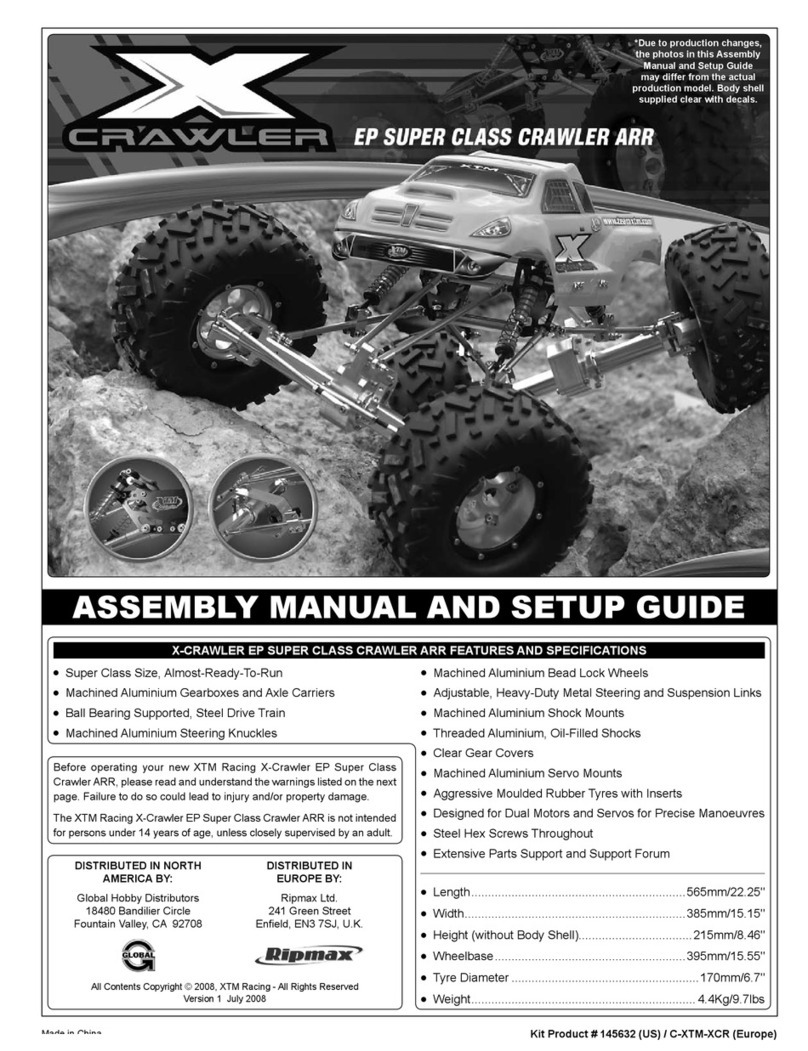Page 2
ENGINE WARNINGS
●Never use any fuel in your engine other than glow fuels
specically designed for use in model car engines. Use of any
other types of fuel can cause severe damage to your engine
and/or personal injury. NEVER USE GASOLINE/PETROL OR
DIESEL FUEL!
●Never operate your model on any public streets. This could
cause trafc accidents, personal injury or property damage.
●Glow fuel engines emit exhaust vapours that are poisonous
and can be dangerous to your health. It is important that you
operate your engine in a very well-ventilated area, preferably
outdoors.
●Before starting your engine, make sure that the throttle trim is
set to the idle position. Starting your engine at any setting above
idle can cause the model to lurch out of your hands.
●When your engine is running, there are certain parts that
rotate at high speeds. Be careful not to touch the drive shafts,
gears, clutch assembly or any other moving parts. Otherwise,
serious injury could result.
●It is normal for your engine and tuned pipe to get very hot
during operation. Never touch these parts while they are hot
or you could be burned.
●Model car engines produce vibration when they are running.
It is important to periodically check the engine mounting screws
and other assemblies to ensure they are tight. Running your
engine with the engine mounting screws loose can lead to severe
engine and/or chassis damage.
FUEL WARNINGS
●Glow fuels like those used in your model are poisonous. Follow
all the precautions that are printed on the fuel manufacturer's
container.
●Keep glow fuel out of the reach of children.
● Glow fuel is extremely ammable. Keep away from high heat,
sparks and ame.
GENERAL WARNINGS
●Under no circumstances should you operate your model in
crowds of people. Serious injury could result.
●Never operate your model on busy streets or if there are
cars around.
●Do not use your model to chase pets or other animals.
●The receiver and battery boxes are not waterproof; therefore,
do not drive through water, wet grass, mud or snow.
●Because your model is operated by radio control, it is important
to make sure you always are using fresh and/or fully charged
batteries. Never allow the batteries to run low or you could lose
control of the model.
●If your model becomes stuck, allow the engine to idle, then
retrieve your model by hand.
●To prevent excessive r.p.m. from damaging your engine and/or
drivetrain components, we suggest reducing throttle while in
the air during jumps.
FOR YOUR SAFETY - PLEASE READ THESE WARNINGS FIRST!
XTM RACING CUSTOMER SERVICE INFORMATION
If you should have trouble with any of the steps listed in this booklet, or if you nd a missing or damaged part in your kit,
please contact your local distributor at the address below:
CHECK OUT OUR WEBSITE FOR MORE INFORMATION ON THIS AND OTHER EXCITING XTM RACING PRODUCTS!
WWW.TEAMXTM.COM
XTM Racing guarantees this kit to be free from defects in both material and workmanship, at the date of purchase. This does not cover any component
parts damaged by use, misuse or modication. In no case shall XTM Racing's liability exceed the original cost of the purchased kit.
In that XTM Racing has no control over the nal assembly or material used for nal assembly, no liability shall be assumed for any damage
resulting from the use by the user of the final user-assembled product. By the act of using the final user-assembled product, the user
accepts all resulting liability.
In North America:
Global Services
18480 Bandilier Circle
Fountain Valley, CA 92708
Phone: (714) 963-0329
Fax: (714) 964-6236
Email: service@globalhobby.net
In Europe:
Ripmax Ltd.
241 Green Street
Phone: (0) 20 8282-7500
Fax: (0) 20 8282-7501






























